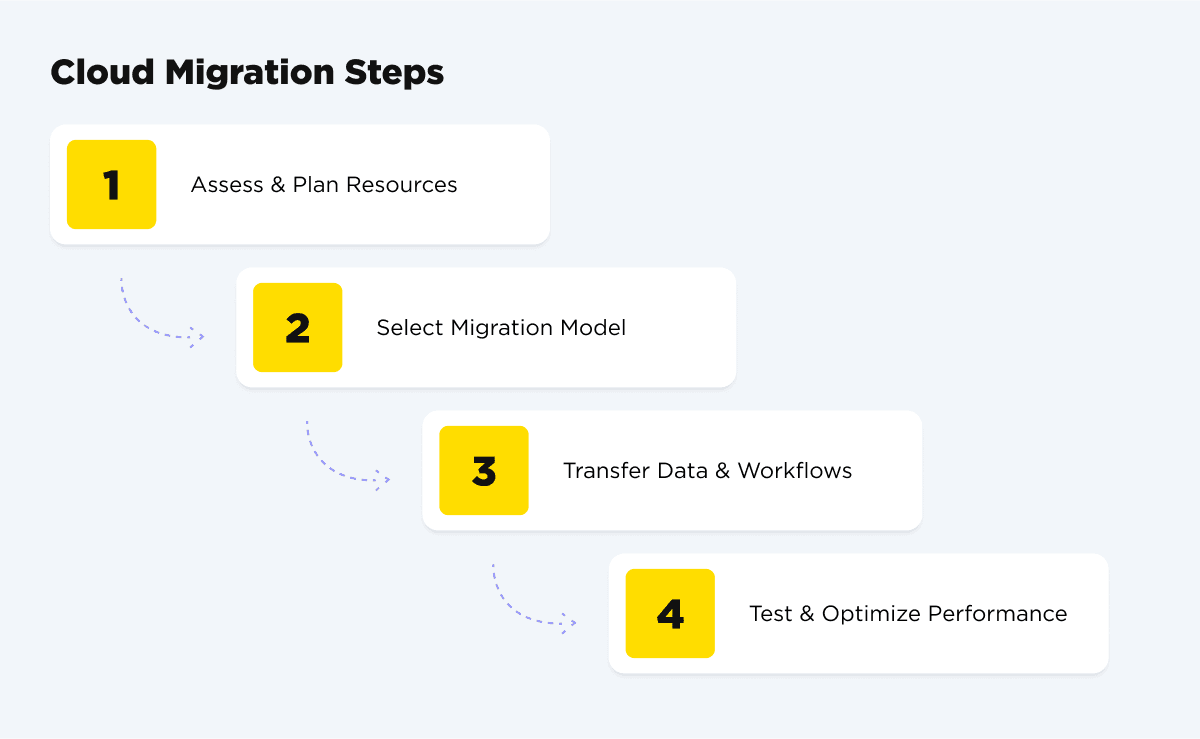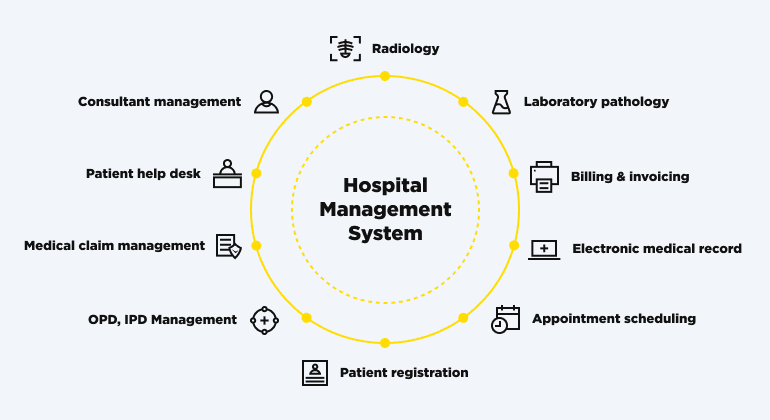Even though some people consider cloud migration to be some kind of trend, it is actually a tech revolution. It doesn’t matter whether you are a startup or a large and established enterprise, cloud migration opens up many opportunities for all. In this article, we try to take you on a journey of discovering all the intricate details, types, benefits, and processes of cloud migration. Of course, you’ll find reasons why partnering with a software company like OTAKOYI might be the perfect move. If you are ready to dive deeper, let’s go!
Quick Overview Of Cloud Migration
When you are a business owner, you are well aware that there is always some data to manage. Everything is about data! Nowadays, it is crucial, probably critical, to handle this data in a secure way. No wonder such cloud-based solutions have appeared. To put it simply, this encompasses the process of moving data, applications, and even entire workloads to the cloud. However, you shouldn’t think that it’s just moving a few files around! It goes way beyond that. It completely changes how companies store, access, and manage their cloud resources. There are many benefits businesses get as a result (flexibility, efficiency, and even security; don’t rush, we’re going to speak more about that part).
Now, you might be wondering, “Why should I be interested?” Well, we’ve got some news for you! According to O’Reilly’s report, more and more organizations are slowly waking up to the benefits of migrating to the cloud. This report states that 48% plan to migrate at least half of their applications to the cloud. And 20% intend to move all their applications to the cloud. Sounds exciting, right? The ball is in your court - what group do you belong to?

How Do You Define Cloud Migration?
The most anticipated question - what is cloud migration? We will try to be clear and understandable. Cloud migration is about moving all your digital operations to the cloud. In the past, companies would run apps, store data, or host files on local servers or personal computers (usually, these physical servers required increased security measures, would be located in safe areas, and would need a lot of maintenance and attention). However, with cloud migration, you can use cloud service providers like Amazon Web Services (AWS), Microsoft Azure, or Google Cloud to handle all of that. As a result, you get much easier and wider accessibility, effortless management, and much lower expenses. What is more, you can have your team working practically from anywhere.
When you hear that some companies decide to move their operations to the cloud, it’s not because of tech for tech’s sake. Usually, it comes from some enterprise demands, circumstances, or threats. Ukrainian bank Monobank, for example, has decided to completely move their operations, app and data to the cloud when the country was invaded. This way, Monobank was able to ensure the clients that all their sensitive data was protected.
There are many reasons and benefits to opt for cloud migration. And we are going to find it out later in the article. let’s find out more about this strategic solution for any business opportunity.
Cloud Migration: How Does It Work?
The journey to the cloud isn’t as simple as copying data and pasting it into a new folder. We bet you wish! Unfortunately, the process of cloud migration is more intricate and requires a well-thought-out strategy. It should guarantee that data, applications, and workflows all function smoothly post-migration. So, how does it work? We have prepared aa break-down of the main stages of this process for you to understand better.

#1 Assess and plan
First of all, you start assessing and figuring out what parts of your system are ready to move and which parts might need some work. This stage also helps identify costs, timeframes, and resources.
#2 Choose a cloud migration model
There are different models of cloud services (we’ll get to those sooner than you think). That is why deciding which model fits your company’s needs is essential.
#3 Actual migration stage
This is where you actually move the data, workflows, and applications. There are many factors that define the approach. This migration process can happen all at once or requires breaking down into small, doable steps to avoid any disruption.
#4 Testing and optimizing
Post-migration is an important step. You should test everything to make sure it’s working as expected. If needed, cloud migration companies optimize any workflows and legacy systems to get a full competitive advantage of the cloud.
When everything is done right and you successfully migrate to the cloud, it can bring incredible efficiency and cost savings (yet again, we are going to speak about them later in the article). But without proper planning, it can be costly and complicated. And messy, to tell the truth. That’s why having a solid plan (and a dedicated software partner) is essential.
What Are The Key Migration Deployment Models?
Migration to the cloud doesn’t start until you choose the right cloud deployment model. It reminds picking the perfect setup for your unique business needs and goals. There are some most popular options to choose from. let’s find them out.
#1 Public cloud
Public clouds (like AWS or Google Cloud, which we’ve mentioned earlier) share resources with other organizations. However, they are managed by an external provider. This option is great if you are looking for budget-friendly options. The only disadvantage is that it may not offer the same level of customization as private options.
#2 Private cloud
As mentioned before, private clouds are dedicated solely to one organization. It means that they offer greater security and control. It can be completely tailored to your needs. But you should be ready to pay a capital expenditure for such solutions.

Ready to elevate your business and smoothly move to the cloud?
Contact us#3 Hybrid cloud
It is not difficult to guess that hybrid clouds are like a mixture of public and private cloud setups. It lets companies enjoy the benefits of both models, using private resources for sensitive data and public resources for everything else. It is a great option when you want to save some costs yet are not ready to sacrifice customization capabilities.
#4 Multi-cloud
This deployment model uses multiple cloud providers to avoid relying on just one. It is your to-go option when you need flexibility and want to diversify your security. The only disadvantage is that it can add complexity in terms of management.
Migration Service Models: What Are The Most Common?
There are different types of platform service models and how you can migrate to the cloud. Each of them covers a range of needs. This part is a bit technical. We will try to give you the main specifics to understand which is what.
#1 IaaS (Infrastructure as a Service)
Applying this cloud migration service model, companies basically servers and storage from a cloud computing provider. However, they are still responsible for managing their own operating system and applications.
#2 PaaS (Platform as a Service)
When you choose PaaS, you get access to a cloud platform to build, test, and deploy cloud-based applications. This way, you don’t worry about the infrastructure at all.
#3 SaaS (Software as a Service)
When picking SaaS, you can expect to get a service that delivers applications through the cloud. What do you get? CRM, project management software, and even accounting apps. Moreover, the cloud provider handles all updates and maintenance.
What cloud service to choose depends solely on your business needs and requirements. The best way to identify what you need is to ask your software partner. Their engineers will definitely have an answer to what type would work best for your business.
Defining The Main Types of Cloud Migration
You may start thinking to yourself, “Are you serious? Cloud deployment types, clour service. And now cloud migration types?” Well, we’ve prepared you that cloud migration isn’t one-size-fits-all. And we’ve already mentioned that there are a lot of factors that may influence the choice of cloud migration scenario. Depending on that, we’ve decided to come up with the main cloud migration types.
#1 Rehosting (“Lift and shift”)
This is the simplest approach. It is about moving data and legacy applications to the cloud as they are. It’s fast but doesn’t always take full advantage of cloud capabilities (sometimes, you do need to adjust and change your data to make the most of cloud migration, though).
#2 Replatforming (“Lift, tinker, and shift”)
In this scenario, you make minor tweaks and changes in order to optimize applications for the cloud. However, it is not a complete overhaul.
#3 Refactoring (or re-architecting)
Unlike previous types, this one involves redesigning applications from scratch. This way, you are able to make full use of cloud features. Even though it’s the most complex process, it offers the best benefits of cloud computing.
#4 Repurchasing
As you can already understand, sometimes, it’s easier just to switch to a cloud-native software solution rather than moving an existing one. This type of cloud migration takes more time, but you don’t need to “reteach” all the functions but just build them from scratch.
#5 Retiring and retaining
Depending on the situation, not every system needs to make the migration. Some apps might be retired, while others stay on-site. This is like a hybrid migration.
Well, the choice of the cloud migration type is difficult and very technical. So, you might have already realized you definitely need to partner with a software company like OTAKOYI to help you with your move to cloud computing.
What Benefits Do You Get When Establishing Cloud Migration?
We have reached the part with the most interesting information – what are the benefits of cloud migration? Let’s finally find it out.

Scalability and flexibility
Scaling up or down is as easy as pressing a button. This flexibility is a game-changer for growing businesses. Machine learning, cloud migrating, AR, and VR solutions – these and others are the future of flexibility and scalability. For example, Netflix uses cloud services for scaling their streamlining capabilities (especially during peak usage).
Cost efficiency
Cloud landscape can completely handle the cloud-based infrastructure, so you don’t have to invest in hardware or pay for IT maintenance. Instead, you pay only for what you use. Dropbox, for example, moved to the cloud to reduce its hardware expenses.
Improved collaboration
With cloud-based systems, teams can access and work on the same files from anywhere, boosting productivity, team collaboration, and interactions within networks. The best example is Google Workspace: they allow people from different corners of the world to work on the document.
Data security
Cloud providers have rigorous security measures in place, including encryption and regular security updates. While moving data might feel risky, most top providers have security nailed down. As we’ve already mentioned, Ukrainian bank Monobank moved to the cloud for better security.
Real-time and reliable analytics and insights
Having real-time analytics and data at your fingertips lets you make quick, informed decisions. Imagine tracking customer trends as they happen or analyzing website traffic in real-time. Let us suggest Starbucks. It uses cloud-based data to better analyze its customers' preferences and needs.
Effortless maintenance
Fewer premises data centers on-site mean less maintenance. Plus, cloud providers handle updates, freeing up time for IT teams. Sounds like a smart investment, don’t you think? A popular company Salesforce, for example, automates many maintenance and update processes within its cloud-based CRM platform.
Sustainability
Running your operations in the cloud can reduce your carbon footprint, especially when providers use renewable energy sources. Google Cloud, for example, has a strong commitment to renewable energy, and it has significantly reduced its carbon footprint.
How Do You Eliminate Potential Challenges When Moving To The Cloud?
Moving to the cloud has its challenges. And even though there are various challenges of cloud migration that you might face, there’s always a cure to that! We’ve prepared the main options for such obstacles and solutions for how to handle them.
Data migration
Transferring large data sets can be slow and complicated. One way to make this smoother is through phased migration and data cleanup.
Security and privacy
Cloud security is robust, but no system is flawless. Encrypting data and knowing your provider’s security protocols can mitigate risks.
Compliance
Industries like finance and healthcare have strict regulations around data. Working with providers that meet industry standards is crucial.
Cost management
While cloud solutions are cost-effective, the cost of ownership can creep up if you don’t monitor usage. Regular audits help you stay on budget and avoid any disasters.
Vendor lock-in
Avoiding lock-in can be tricky, but using a multi-cloud approach or hybrid cloud configuration setup helps keep your options open.
Expertise gap
Cloud migration requires specialized knowledge. Training staff or partnering with experts like OTAKOYI ensures a smooth transition.
Business workfow
Migration can cause downtime. Having clear cloud migration strategies minimizes interruptions to daily operations.

Are you willing to experience all these benefits?
Contact usHow Does The Process of Cloud Migration Look?
As we’ve already mentioned, moving to the cloud is a thorough process. Here we have prepared a common roadmap for cloud migration. This is a simple explanation of how everything is done.
#1 Planning
Establish your goals, map current architecture, and prepare a realistic timeline.
#2 Assessing
Determine which applications, workflows, and data to migrate and review dependencies.
#3 Executing
Begin migration, whether as a one-time move or in phases for complex systems.
#4 Testing
Make sure everything works smoothly and follows regulatory compliance.
#5 Optimizing
Once migrated and tested, analyze performance and make adjustments.
#6 Monitoring
Continuously review and optimize your cloud migration to prevent inefficiencies.
Partner With OTAKOYI For A Smooth Cloud Migration
Never be left all by yourself to deal with cloud migration. You do need a dedicated team to help you with navigating through this process. When you partner with OTAKOYI, you receive end-to-end support and have peace of mind that your migration is seamless, ensuring cost efficiency and customization.
Our experts make sure you get:
#1 Strategic planning (ensuring your tailored migration plans are aligned with your business goals);
#2 Thorough assessment (evaluating your current infrastructure to make a smooth transition);
#3 Customized deployment (offering flexible deployment options to meet your goals and fit existing systems);
#4 Security and compliance (following top-notch and latest industry-related security and compliance standards);
#5 Performance optimization (conducting continuous updates for cost-efficiency and improved performance);
#6 Ongoing maintenance (providing post-migration services to scale up your business or update it when needed)
With the OTAKOYI team, you’re not just migrating to the cloud, but you’re setting up for long-term growth.





